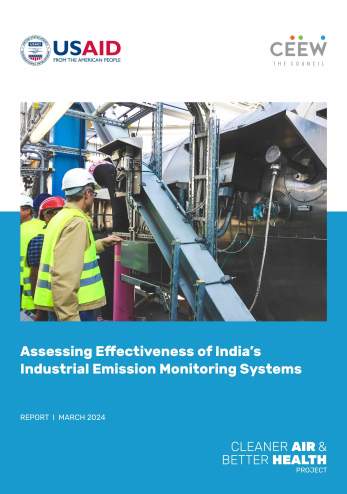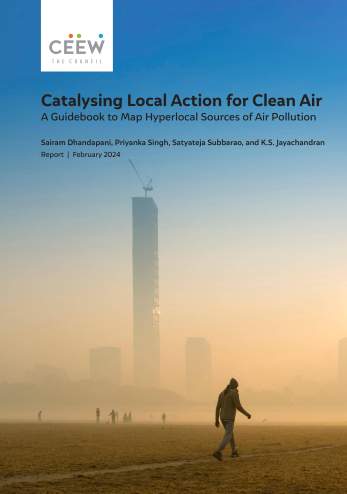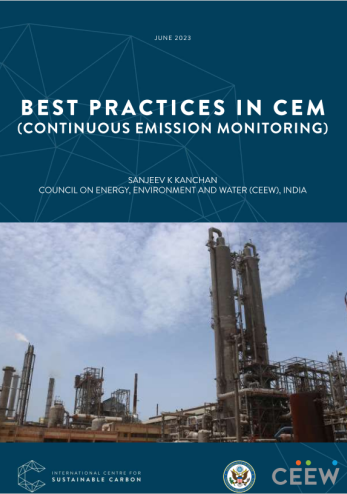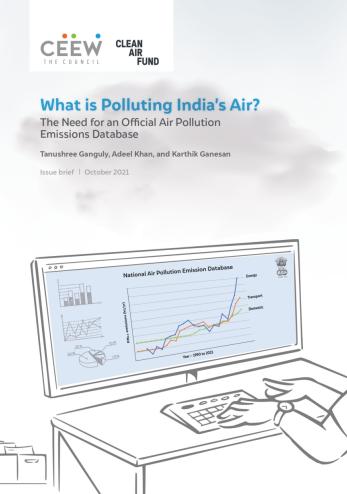



Suggested citation: Kurinji, L. S, and Srish Prakash. 2021. Why Paddy Stubble Continues to be Burnt in Punjab? Meeting Challenges with Solutions. New Delhi: Council on Energy, Environment and Water.
This study examines the drivers of continued stubble burning in Punjab and reflects on the state's preparedness towards managing crop residue in the winter of 2021. It is based on a multi-stakeholder consultation that included interviews with officials from the Department of Agriculture, Krishi Vigyan Kendras, operators of Custom Hiring Centres (CHCs) and representatives from farm unions across 17 districts to capture varying perspectives on the issue. The study also aims to support the Punjab government in identifying pitfalls in the existing policy landscape and ensuring timely access to crop residue management options to farmers.
Millions of people living in the Indo-Gangetic Plains (IGP) bear the brunt of the decades-old crop residue burning practice in Punjab, which jeopardises their health in multiple ways. In the past, the central and state governments have implemented several policy measures ranging from subsidising crop residue management (CRM) machines to providing cash incentives for small farmers, who do not burn the straw, to banning crop residue burning. However, despite the intent and efforts, stubble burning persists and presents an important public policy conundrum.
Millions of people living in the Indo-Gangetic Plains (IGP) bear the brunt of the decades-old stubble burning practice1 in Punjab, which jeopardises their health in multiple ways. The economic and health impacts of this practice has led to the formulation of an array of policy measures targeted at reducing crop residue burning (Balakrishnan et al. 2020). These policies range from subsidising crop residue management (CRM) machines to incentivising small farmers who do not burn to an outright ban on crop residue burning (MoAFW 2018; Rambani 2019; PTI 2019). Despite efforts for several years by various arms of the government, the farm fires have spiked in 2020, as residue burning was reported from more than 50 per cent of the area sown under paddy (CREAMS 2020). Therefore, this issue poses a serious concern.
With yet another stubble burning season not very far away, we reflect on the state’s residue generation and preparedness for managing residue from paddy in the upcoming season. To gain an understanding of the scenario, we interviewed a host of stakeholders across 17 districts in Punjab and gathered insights on the accessibility and affordability of crop residue management solutions and farmers’ preferences for the available solutions. Besides generating primary data from stakeholders, we used secondary data from government reports, parliamentary questions, and newspaper articles to assess the implication of changes in the notified date of sowing, the area under paddy, the number of in-situ CRM machines, and ex-situ utilisation capacity.
Despite Punjab government’s efforts to diversify the Kharif crop mix, paddy remains the dominant Kharif crop in the state (ESOPB 2020). This year, the state’s area under paddy was 30.66 lakh hectares, declining marginally by 2.63 per cent from 2020 (31.49 lakh hectares). In addition, despite a gradual decline over the last five years, the late-maturing high-profit PUSA 44 variety of paddy remains the dominant seed variety (Nibber 2020, 2021a). Further, this year’s notified date of paddy transplantation was the 10th of June (The Tribune 2021a). This should theoretically provide farmers with ample time to manage the residue. However, the same was true last year (transplantation date was 13th June), and yet the number of fire events in 2020 was the highest in the last four years (Joshi 2021; PRSC 2021).
Despite an increase in the number of in-situ crop residue management (CRM) farm implements deployed, their adoption remains limited. According to government records, by 2020, 76,626 CRM machines were deployed in Punjab, which includes 13,316 Happy Seeders and 17,697 Super Seeders. Sangrur district has the maximum number of Happy and Super Seeders, followed by Muktsar, Bathinda, and Mansa.
The state though is still short of CRM machines to cater to the large area under paddy (Hindustan Times 2021a). The current penetration of these machines in a few high-burn districts such as Amritsar, Patiala, and Ludhiana is far below the ideal requirement and therefore needs to be scaled up significantly. The existing stock, if deployed at full capacity, is estimated to cover only 17 lakh hectares in Punjab, which corresponds to 66 per cent of area sown under non-basmati variety in 2021. In addition, a majority of these machines remain underutilised. Farmers’ misperceptions of the impact of the Happy Seeder on the productivity of wheat sown using this machine is a cause of its low popularity. The custom hiring centre (CHC) system, which was meant to improve access to these machines, has not achieved the expected rates of adoption. The rental model is plagued with delays and sees poor uptake as a significant proportion of farmer’s desire to own a CRM machine. The awareness of FARMS App, which was aimed to popularise the CHC model and create an online marketplace for renting CRM machines, is quite poor among the farmers. Further, diesel price hikes in 2021 have led to the operational cost of Happy Seeder and Super Seeder going up, respectively, by 8.25 and 5.25 per cent, compared to 2019 price levels, reducing their appeal among the farmers.
and continues to remain below 1 million tonnes, which is less than 6 per cent of the paddy residue generated in the state. The high cost of densified biomass and lack of supply chain actors like biomass aggregators, processors, and storage facilities have made the existing ex-situ ecosystem a laggard. The state’s recent policy measure allowing industries to use crop residue in their boilers is a step in the right direction (DIPR Punjab 2021). However, this policy is expected to take time to mature and may have only a little impact on the forthcoming season.
A recent addition to the suite of in-situ CRM is the PUSA decomposer, which manages crop residue within two to three weeks of application (The Hindu 2021). A single packet, costing INR 20, mixed with 25 litres of water can be used for residue generated from one hectare of land (Mohan 2021b). The PUSA decomposer thus presents an economically viable and time-efficient solution to stubble burning. Still, the development and adoption of the decomposer are at a nascent stage. In 2020, its use was limited to 200 hectares across five villages in Punjab (PIB 2021). While the decomposer might be economically viable and eco-friendly, its potential needs to be demonstrated at a large scale for improving farmers’ awareness and finding their acceptance.
The prevailing sentiments due to the recent agricultural reforms have had an undesired impact on stubble burning. The Commission for Air Quality Management in National Capital Region and Adjoining Areas Act, 2021 empowers the commission to levy an environmental compensation on farmers for stubble burning, adding momentum to the prevailing sentiments (MoL&J 2021; Mohan 2021a). The persistence of these sentiments poses a major barrier to the efforts in reducing crop residue burning.
Recognising the seriousness of the stubble burning issue in Punjab, we interacted with relevant stakeholders to identify the variables that influence stubble burning, understand how they have changed in recent times, and the implication of these changes. Our assessment indicates that it is unlikely that there will be a significant reduction in crop residue burning in the Kharif season 2021 in Punjab. The silver lining though is the increasing stock of CRM machines and the emergence of the Super Seeder, which despite its high operational cost, has become a farmer’s favourite. Better logistical management and targeted outreach can lead to reduced crop residue burning. For this statement to hold, we recommend the following five E’s:
The per hectare operating cost of the Happy Seeder has increased from INR 4,850 in 2019 to INR 5,250 (an increase of 8.25 per cent) in 2021 due to fuel price hike. For the Super Seeder, the same cost has increased from INR 6,290 in 2020 to INR 6,620 (an increase of 5.25 per cent) in 2021. The rising cost would prove to be a hurdle to the sustained use of these machines. Given the state government’s inability to alter fuel prices, we suggest direct benefit transfers to the users of these machines to compensate for the rising fuel prices. The government should use its existing system of agricultural officers, the panchayat network, and specially designated nodal officers to identify the users of these machines and quantify their use. In addition to these steps, the state government should test the PUSA decomposer for its effectiveness in residue management and economic viability. The use of the decomposer should be demonstrated on a large scale to ensure farmers’ awareness and acceptance.
Our interviewees point to delays in the deliveries of CRM machines in the previous years. These delays contribute to the inefficient utilisation of these machines and this problem has been flagged previously. The agricultural engineering wing of the Department of Agriculture in Punjab must track the delivery of these machines and ensure that they are deployed well before the start of the harvest season.
The state government should initiate campaigns to reduce the apprehensions attached with the rental model. In addition to this step, information campaigns covering the benefits of the Happy Seeder should be initiated to ensure that the existing stock of Happy Seeders does not become redundant. The state government’s rental advisories for CRM machines have not been revised since 2019. We recommend annual revision of these rates to reflect ground realities and make these rates legally enforceable. As an immediate measure, we recommend that the state government uses social networking platforms such as text messages, WhatsApp, Facebook, and other avenues to share the details of these CHCs at the block level to increase their reach beyond their immediate social networks. The state is also launching its own farm machinery rental app called i-khet. The government should launch campaigns to popularise the app and familiarise farmers with its interface and services (Hindustan Times 2021c). The central government has earmarked INR 10 crore in 2021 for publicising its flagship CRM scheme. These funds must be utilised effectively to create behavioural change among the farmers and to promote the FARMS and i-khet apps. In addition, the central government should geotag the CRM machines provided under its subsidy scheme to understand their usage and ensure that they are being utilised up to their maximum capacity.
The state government should verify and ensure that all the existing biomass-based power plants are operating at their maximum capacity. The government had plans to commission two biomass-based power projects and two bio-CNG projects across three districts in the current financial year (EPCA 2020). However, it is not clear whether these plants have been operationalised yet. It is imperative that these plants become operational at the earliest. At the minimum, the state government should ensure that these plants initiate biomass procurement and storage. Besides, the government should also ensure access to ex-situ machines and panchayat lands for handling and storing the residue that these plants can utilise. The central government should also include ex-situ machines under its flagship CRM scheme to enhance their availability.
The state government has previously penalised crop residue burning (Sally 2020). Given the current state of the political economy, enforcing this punitive measure would be difficult in the forthcoming season. However, the state government can use this tool as a last resort to particularly discourage protest burning.
The decades-old practice of stubble burning in Punjab has been resulting in a serious air pollution crisis in northern India. Despite a slew of policy measures and judicial directives, the practice continues to persist. We interacted with relevant stakeholders from 17 districts across Punjab to examine the factors contributing to continued burning in the state and their influence on the current Kharif season. Our discussions suggest that farmers’ choice of CRM depends on the quantum of residue generation (a function of paddy variety and area sown), accessibility, and affordability of CRM solutions.
Despite Punjab government’s effort to diversify crops, paddy remains a dominant crop in the state. In 2021, over 30.66 lakh hectares were sown under paddy, of which 25.81 lakh hectares were under the non-basmati variety. Despite displaying a declining trend in the sown area, the long-duration, high-residue PUSA 44 remains a dominant variety of paddy, at least in the high-burn districts. The lack of significant changes in the area under paddy and continued cultivation of the dominant paddy variety makes it evident that the state has missed out on controlling the quantum of residue that will be generated in the forthcoming season.
Importantly, the state’s ex-situ residue management capacity has also remained stagnant for the last three years. Several projects that were to be commissioned this year have missed their commissioning deadlines. The only development in the ex-situ front has been the state government announcing the policy on allowing and incentivising the use of crop residue in industries in NCR power plants. However, this policy is likely to take time to mature and yield results.
In-situ management remains the most viable CRM option this year. However, our analysis has identified several problems with its adoption at a large scale. These include the inadequacy of the existing stock of the seeder machines, poor utilisation of the available machines, the dismal performance of custom hiring centres, the high operational cost of these machines visà-vis the rising diesel price, and farmers’ perceptions in light of the recently enacted farm laws.
Our assessment concludes that Punjab has a long way to go to eliminate crop residue burning. The reduced area under non-basmati paddy and the rising stock of the Happy Seeders and the Super Seeders presents an opportunity to control burning in the forthcoming season. However, grasping this opportunity requires augmenting the supply of CRM machines, better logistical management of the existing stock of CRM machines, ensuring the financial viability of using these machines, increasing ex-situ utilisation capacity, and dedicated outreach to farmers to bring about their behavioural change.

Assessing Effectiveness of India’s Industrial Emission Monitoring Systems

Catalysing Local Action for Clean Air

Best Practices in CEM (Continuous Emission Monitoring)

What is Polluting India’s Air? The Need for an Official Air Pollution Emissions Database